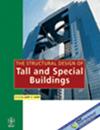基于构件损伤的高层转换结构地震易损性分析
IF 1.3
3区 工程技术
Q3 CONSTRUCTION & BUILDING TECHNOLOGY
引用次数: 2
摘要
脆弱性分析是评估高层建筑地震风险的有效工具。在脆性分析过程中,确定不同损伤状态对应的工程需求参数(EDP)非常重要,因为它们直接影响脆性结果。然而,对于具有转换结构的建筑物,很难确定与不同损坏程度相对应的EDP,因为此类建筑物的最大需求大多集中在不规则程度。获得构件水平的脆性曲线(用于桥梁结构)可以为具有转换结构的建筑物的地震脆性分析提供新的见解。由于结构系统和地震反应的差异,这种方法是否可以直接应用于高层建筑的脆弱性分析可能值得怀疑。有鉴于此,本研究提出了一种适用于高层建筑的基于构件损伤的方法,并提出了一个详细的框架,通过该框架可以获得脆性曲线。该方法用于评估一栋34层带转换板的混凝土建筑的地震风险。通过损伤指数(DI)模型获得了各种结构构件的损伤状态。通过云分析生成了构件的DI与最大层间漂移比(MIDR)之间的关系,并获得了不同构件损伤状态对应的MIDR。对部件和系统两个层面的脆性曲线进行了评估。数值结果表明,在PGA(0.2 g)的保守水平下,建筑物的主要构件发生不可修复损坏的概率很小,可以满足基于性能的抗震设计要求。本文章由计算机程序翻译,如有差异,请以英文原文为准。
Component damage‐based seismic fragility analysis of high‐rise building with transfer structure
Fragility analysis is an effective tool used to assess the seismic risk of high‐rise buildings. During the process of fragility analysis, determining the engineering demand parameters (EDPs) corresponding to different damage states is of great importance as they directly influence the fragility results. However, for buildings with transfer structures, the EDPs corresponding to different damage levels are difficult to determine since the maximum demand in such buildings is mostly concentrated at the level of irregularity. Obtaining the fragility curves at component level (as used for bridge structures) may provide new insight into the seismic fragility analysis of buildings with transfer structures. Due to differences in structural systems and seismic response, it may be questionable whether such an approach can be directly applied to the fragility analysis of high‐rise buildings. In view of this, a component damage‐based approach suitable for high‐rise buildings and a detailed framework through which to obtain the fragility curves are proposed in this study. This method was applied to assess the seismic risk of a 34‐story concrete building with a transfer plate. The damage states for various structural components were obtained through a damage index (DI) model. The relationship between the DIs of the components and the maximum inter‐story drift ratios (MIDRs) was generated by cloud analysis, and MIDRs corresponding to different component damage states were obtained. The fragility curves at both component and system levels were evaluated. Numerical results indicate that, at the conservative level of PGA (0.2 g), the probability that the main components of the building incur irreparable damage is small, and the performance‐based seismic design requirements can be met.
求助全文
通过发布文献求助,成功后即可免费获取论文全文。
去求助
来源期刊
CiteScore
5.30
自引率
4.20%
发文量
83
审稿时长
6-12 weeks
期刊介绍:
The Structural Design of Tall and Special Buildings provides structural engineers and contractors with a detailed written presentation of innovative structural engineering and construction practices for tall and special buildings. It also presents applied research on new materials or analysis methods that can directly benefit structural engineers involved in the design of tall and special buildings. The editor''s policy is to maintain a reasonable balance between papers from design engineers and from research workers so that the Journal will be useful to both groups. The problems in this field and their solutions are international in character and require a knowledge of several traditional disciplines and the Journal will reflect this.
The main subject of the Journal is the structural design and construction of tall and special buildings. The basic definition of a tall building, in the context of the Journal audience, is a structure that is equal to or greater than 50 meters (165 feet) in height, or 14 stories or greater. A special building is one with unique architectural or structural characteristics.
However, manuscripts dealing with chimneys, water towers, silos, cooling towers, and pools will generally not be considered for review. The journal will present papers on new innovative structural systems, materials and methods of analysis.

 求助内容:
求助内容: 应助结果提醒方式:
应助结果提醒方式:


